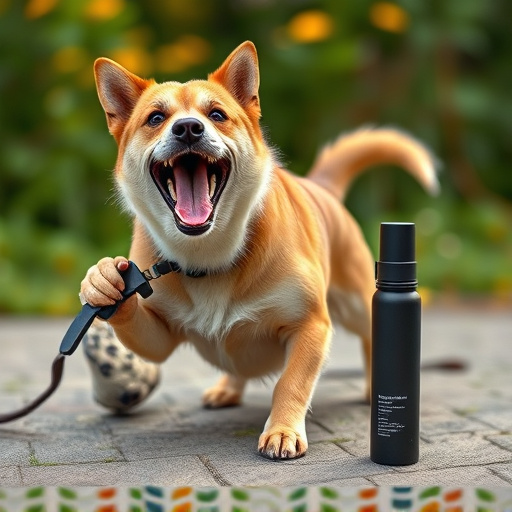Self-defense spray for dogs (dog pepper spray) is a controversial yet effective tool against aggressive canine behavior, utilizing capsaicin to irritate eyes and respiratory systems. Local Self Defense Spray Regulations for pets vary widely; pet owners must understand their rights and responsibilities under these laws, ensuring responsible use through proper handling, storage, training, and adherence to application guidelines. Selecting non-toxic, animal-specific products and complying with local regulations is crucial to protect both humans and animals from legal issues and harm.
“In recent years, there’s been a growing interest in self-defense spray for dogs as a means of protection against aggressive animals. This comprehensive guide explores ‘stop dog attack pepper spray’ – its effectiveness, legal considerations, and responsible use. Understanding the regulatory landscape surrounding self-defense spray for pets is crucial before making an informed purchase. We’ll break down key features to consider, offering insights into choosing the right product. Additionally, training tips ensure safe and effective deployment.”
- Understanding Self-Defense Spray for Dogs: A Comprehensive Overview
- The Legal Landscape: Regulations and Restrictions on Pepper Spray for Pets
- Choosing the Right Product: Features and Considerations for Dog Owners
- Training and Safety Tips: Responsible Use of Dog Attack Pepper Spray
Understanding Self-Defense Spray for Dogs: A Comprehensive Overview
Self-defense spray for dogs, also known as dog pepper spray, is a controversial yet effective tool designed to deter aggressive canine behavior. It’s important to understand that this type of spray is not meant to harm pets but rather to incapacitate them temporarily, providing an opportunity for escape or for the owner to gain control during a potential attack. The primary active ingredient in dog pepper spray is capsaicin, similar to what’s found in hot peppers, which irritates the eyes and respiratory system, causing the dog to flee.
When considering self-defense spray for dogs, it’s crucial to be aware of local regulations regarding its use and possession, as these laws vary significantly across regions. Pet owners should also ensure they understand their rights and responsibilities under these regulations. Responsible use involves proper handling, storage, and adherence to application guidelines. Moreover, it’s essential to train pets and owners alike on safety measures to prevent accidental or unnecessary deployment of the spray in non-threat scenarios.
The Legal Landscape: Regulations and Restrictions on Pepper Spray for Pets
In many jurisdictions, the use of pepper spray for self-defense purposes is heavily regulated to ensure public safety and responsible handling. These regulations extend to pet owners who may consider using pepper spray as a deterrent or defense mechanism against dog attacks. The legal landscape surrounding self-defense spray for pets varies widely across different regions, with some areas allowing its use under specific circumstances while others prohibit it entirely.
Restrictions on pepper spray for pets often focus on the potential harm to animals and bystanders, as well as concerns about misuse and accidental application. Some locales require permits or special training for pet owners to legally carry and use such sprays. Additionally, there may be age restrictions, rules regarding storage and disposal, and limitations on where and how the spray can be deployed to protect both pets and humans from unnecessary harm.
Choosing the Right Product: Features and Considerations for Dog Owners
When considering self-defense spray for dogs, it’s crucial to choose a product tailored to your needs as a pet owner. Look for features designed specifically for animal usage, such as non-toxic formulas safe for pets and their environments. The spray should also be easy to use with simple controls, ensuring you can respond quickly during an attack without causing harm beyond the target area.
Regulatory compliance is another essential consideration. Different regions have varying laws regarding self-defense sprays, especially when it comes to pets. Check local regulations on pepper spray for animals to ensure your chosen product adheres to these rules, protecting both your safety and that of your pet from potential legal issues.
Training and Safety Tips: Responsible Use of Dog Attack Pepper Spray
When considering self-defense options against dog attacks, pepper spray can be an effective tool for those who want to protect themselves and their pets responsibly. However, its use comes with strict regulations and safety considerations. It’s crucial to understand that pepper spray is not just for personal defense; it must be used wisely to ensure the well-being of both the user and animals in the vicinity.
Training is essential. Users should learn how to apply the spray correctly, aiming for the eyes and nose of an attacking dog. Familiarize yourself with local laws regarding self-defense spray, especially when it comes to pets. Always store pepper spray securely, out of reach of children and pets, and keep it in a readily accessible location. Regularly inspect and maintain your spray device to ensure its functionality. Remember, responsible use means respecting both human and animal safety, adhering to legal guidelines, and being prepared for unexpected situations.
In conclusion, while self-defense spray for dogs offers a valuable tool for personal safety, it’s crucial to navigate the legal landscape and choose the right product. Understanding local regulations regarding pet pepper spray is essential, as these laws vary widely. Dog owners should invest time in researching and selecting a reputable brand that aligns with their needs. Additionally, proper training and safety measures are paramount to ensure responsible use, maximizing its effectiveness while minimizing potential risks. By adhering to these guidelines, individuals can better protect themselves and their loved ones from dog attacks.
